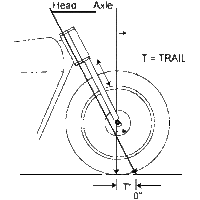In my Factory manuals from 74 up the bikes trail is 4.53 inches.
Leo
I tossed this number around the only way that it is a real number is if given offset 49.23mm, head tube angle 27, and front wheel diameter of .........28.49"
I have a couple in the shop I just measured. 350/19" They're worn but avg out at 26.25" if I plug in my wheels I get 102.18mm or 4.02"
The math is much deeper but everyone should be able to follow this.
Wheel diameter= 26.25"
Fork Offset= 49.23mm
Head Tube Angle=27°
Trail= Radius*Sin90-head tube angle- Fork Offset
Trail= 333.5mm*Sin90-63°)-49.23mm
Trail= 102.18mm or 4.02"
You'd need a wheel assembly height of 28.49" to get the trail numbers listed in manual.
Trail= 361.87mm*Sin90-63)-49.23mm
Trail= 115.06mm or 4.53"
Using my wheel Radius.
Fork Offset= Radius * Sin90- Head Tube Angle) -Trail
Fork Offset= 335.5mm*Sin90-63°) - 102.18mm
Fork Offset= 49.23mm
Using manuals wheel Radius.
Fork Offset= 361.87mm*Sin90-63°) - 115.06mm
Fork Offset= 49.23mm
I came to the conclusion that they, yamaha, didn't include the tire's contact patch. This proves just that-
Trail= Trail- contact patch*Sin63°)
Trail= 115.06mm*Sin63°)
Trail= 102.52mm
or
Trail= Trail+contact patch/2/Sin63°)
Trail= 102.52mm/Sin63°)
Trail=115.06mm or 4.53"
if you view the above diagram @650Skull post. Image a flat spot on the bottom of the tire where it meets the ground. Divide that in half and draw a line perpendicular to the steering axis. Thats actually the trail drawn and what designers and engineers use.
Don't be confused in thinking you can just lower your forks. If you put a 1" spacer in you head tube angle will change.
New Head Tube Angle= Tan`{WB*Sin63°)÷(WB*Cos63°)-amount lowered}
New Head Tube Angle= Tan`{1435.1mm*Sin63°)÷(1435.1mm*63°) - 25.4mm}
New Head Tube Angle= 63.88°
That's given some knows as rear trail, contact patches, axle to crown race etc
Well kids if you have any questions ask. My planes about to land for the Talladega NASCAR race!
 Posted via Mobile
Posted via Mobile




 this thread is very helpful thanks to all those adding their research !!
this thread is very helpful thanks to all those adding their research !!